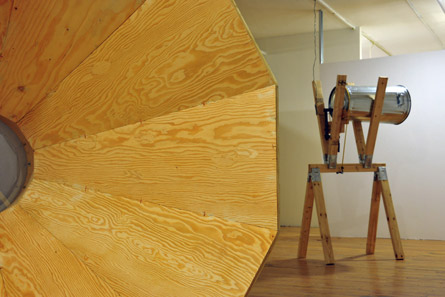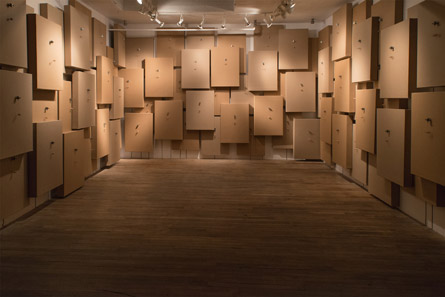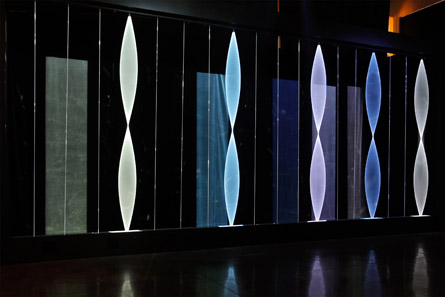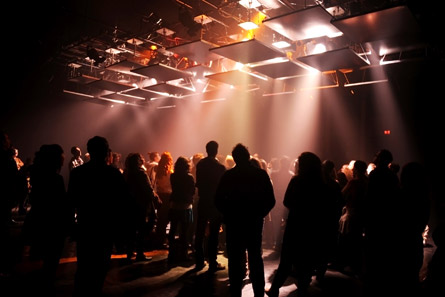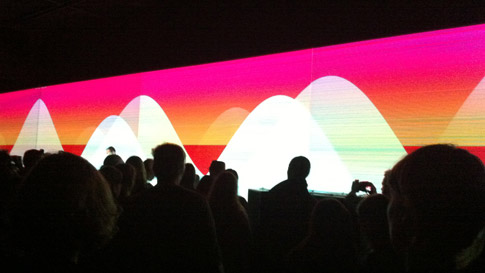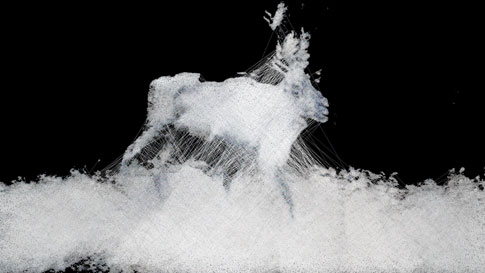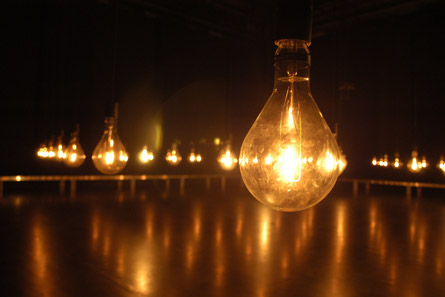INTERNATIONAL DIGITAL ARTS BIENNIAL
by Dominique Moulon [ June 2012 ]
The first International Digital Arts Biennial began in April 2012 in various locations around Montreal including the Museum of Fine Arts, the Contemporary Art Museum, the DHC and the SAT. Alain Thibault, its founder, is also the artistic director of the Elektra Festival and the instigator of the International Digital Art Market. In May, the Syncretic Transcodings symposium organised by Hexagram CIAM was added to the events taking place in Montreal. Here is a review of some of the highlights.

Too human
Bill Vorn,
"DSM-VI", 2012
 T
The Black Box of the
Hexagram research laboratory at Concordia University is among the spaces invested by the International Digital Arts Biennale (
BIAN). The robotic creations of the artist
Bill Vorn can be found there. Metallic bars obstruct our movements in a space invaded by machines. Those that can be found around the perimeter of the room seem to express the desire to communicate while those located in the centre appear more menacing, because they are more human; perhaps even too human? The lower limbs of the robots on the floor flail about desperately in the emptiness while they continue to scrutinise the space with their luminous heads. The title of the exhibition "DSM-VI" is a reference to the Diagnostic and Statistical Manual of Mental Disorders, the version V of which is awaited with impatience by as many users as there are detractors. We should perhaps reconsider our relationships to the robots that invest our societies. But must we go so far as to name the troubles of which they're still blissfully unaware?

Vibrational Sculptures
Peter Flemming,
"Instrumentation",
2011, source
Conception Photo.
 C
Crossing the rue Sainte Catherine we reach the Belgo Contemporary Art galleries where we can find another partner of the BIAN: the Centre des Arts Actuels
Skol.
Peter Flemming has placed four large sized sculptures here that are in fact resolutely low-tech speakers as they are apparently 'unplugged'. The title Instrumentation for this sonic installation made of objects put to another use takes on its full meaning when one enters the adjacent room, as it's there that sounds emerge from this strange instrument. Piano wires are made to vibrate by a complex device where sensors and activators rub shoulders with found objects. The music of noises that plays out during the time we listened seemed to have been composed, with the machine adding its randomness and where wood, as in the other room, is predominant. The oversized scale of the speakers, the non-amplified music of noises and the predominance of wood all evoke the audacity of another era – that of the inventor artist Luigi Russolo and his Intonarumori of 1913.

Musicality in numbers
Zimoun,
"Prepared dc-motors
on cardboard", 2012,
source Paul Litherland.
 I
If one goes up a bit into the Montreal heights, you will find the
Oboro Centre where one of the galleries has been partially lined with cardboard boxes by the Swiss artist,
Zimoun. And inside each module there is a direct current motor with its metal shaft stuck with a cork ball on its end. From a distance, one thinks one is hearing the echo of distant thunder, but upon coming closer, it is more the sound of a hailstorm that this multitude of electrical devices is generating. The sum of all this pitter-patter is constant but it is also progressive depending on where we are in the space. Observing an instrument, much like in an orchestra pit, means to hear it, whereas looking away we can lose the sound. This sound humbly participates in a sonic chaos, from which a rhythm sometimes emerges that is precisely here and now, its timing still a few beats ahead or behind. After a while, it seems as though everything is in harmony, unless it is our perception being altered by our desire, even unconscious, of wanting to bring order to chaos.

Perpetual revolutions
Jean-Michel Albert
& Ashley Fure,
"Tripwire", 2011.
 A
An entire exhibition came from the Ile de France region to participate in this first BIAN. It is entitled "Out of the Blue / Into the Black" and was presented in the former Fine Arts school. Here the twenty-four wires of the light-kinetic sound installation called "Tripwire" by
Jean-Michel Albert and
Ashley Fure ceaselessly turn vertically and their oscillations in space produce as many shapes. We know that they are only lines, but we nevertheless see objects that are comparable to those obtained by 3D applications. The installation seems to be stuck in time, even though the sound composition is there to alert us to its possible mutations. "Tripwire", when you look at it closely, is only comprised of transitions going from one position to another. The relative instability of the sinusoids from which it is composed give it a suppleness that time only seems to stretch. As for the light, it participates in the spectacle in a manner that could be qualified as being close to pre or post cinematographic.

Infernal descent
Ulf Langheinrich,
"Hemisphere", 2006.
 T
The Society for Arts and Technology (
SAT) was recently equipped with a dome, a Satosphere that
Ulf Langheinrich covers in images for the time it takes to present his audiovisual performance called "Hemisphere". The noise, which has an intense heat in the image as in the sound, is one of the essential elements in this creation dating from 2006, which has been optimised for the occasion. A simple look at those around us, who are all comfortably lying down and totally absorbed, is enough to tell us of the work's influence on the body as well as the mind. Midway, the Satosphere seems to lift up, to literally take off, thus initiating the endless fall of our bodies, which simply surrender to the experience. Images and sounds participate in gradually propelling us downwards to the same degree our now uncontrollable flesh becomes heavier. "Hemisphere" is a sensorial experience that has to be lived and is enough to justify the construction of such a special screening space that other artists, such as Luc Courchesne, have already started to invest in ones similar.

An aesthetic of oppression
Projet Eva, "Cinétose", 2011,
source Conception Photo
 I
In the evening, it is at
Usine C hosting the Elektra Festival that the public attending the BIAN and the participants of the International Digital Art Market (MIAN) find themselves. In the small space there, the collective
Projet Eva give their robotic performance "Cinétose". The spectacle takes place above our heads through what architects refer to as a 'false ceiling'. The metallic plates that make up this artwork are similar to scales in the way they combine with one another. But it is not long before this suspended skin starts to come alive to the rhythm of the powerful metallic sounds it generates. The light filtered by the movements of the beast participates in oppressing the spectators when the entire ceiling comes close to their heads. This machine that becomes increasingly invasive thus threatens our personal space. Consequently, we hope it is not in the least autonomous. Among the public, there are those who remain standing, braving the threat, while other more serene spectators stretch out on the floor to enjoy the show without any, or hardly any apprehension.

The right scale
Alva Noto,
"univrs", 2012.
 D
During the BIAN, the Montreal
Museum of Contemporary Art offered one of the walls of its Black Box to the German artist Carsten Nicolai who hastened to extend it infinitely with a system of mirrors. And for one evening, the audiovisual installation "Unidisplay" became the theatre for the performance of "Univrs" given by the same artist, but under his stage name,
Alva Noto, which is well known to minimalist electronic music lovers. The sounds during the day are barely perceptible whereas he practically shatters our eardrums in the evening. The uncluttered colours of the day are more pure in the evening and the inherent slowness of the "Unidisplay" installation are replaced by an uninterrupted stream during the performance of "Univrs". There is nevertheless a common point between these two works that are presented like landscapes of propositions over which a virtual camera moves to magnify them one after the other. It is thus a voyage in time and space that
Carsten Nicolai, aka Alva Noto, offers us where inevitably entangled sounds and images evolve according to sequences that are more and more radical.

Profound mutations
Ryoichi Kurokawa
& Novi_Sad,
"Sirens", 2012.
 T
The Elektra Festival ends with the performance "Sirens" given by
Ryoichi Kurokawa and
Novi_Sad. Right from the start, in the image and the sound, there seem to be several levels of activity based on multiple temporalities. In detail, the media is extremely unstable as though animated by tiny perpetual radiations. With a bit of distance, it appears that the fragments of bodies, monuments and entire landscapes slowly liquefy. There is noise in the image as there is grain in the sound of a music that combines the digital treatment of economic data with the use of more traditional instruments. The world that offers itself to us is a world in transition where metamorphoses follow upon one another to the rhythm of the tableau that succeed one another. And the frenzy in the detail is in no way opposed to the slowness of what liquefies, breaks up or dries out on a larger scale. But how can we not interpret the research of these two artists, one coming from Japan and the other from Greece, two countries undergoing profound change in a world seeking solutions to energy problems and the other, sustainable economic measures, as possible references to current upheavals?

Condemned to disappear
Artificiel,
"Condemned
Bulbes", 2003.
 T
The Elektra Festival is over, but the BIAN 2012 carries on through mid-June. Our final destination is the Frontenac Cultural Centre to attend an audiovisual performance given by the 1000W bulbs, of the Montreal collective
Artificiel, that produce more heat energy than light. This is primarily the reason why they're gradually being phased out in a growing number of countries, which will cause, in the long term, the disappearance of the installation "Condemned Bulbes". These condemned light bulbs are emitting their last gasps one after the other according to a composition written by the members of the Quebecois collective who power them with electrical current conceived especially for this purpose. The bulb's filaments, whose exaggerated size we have already mentioned, progressively begin to vibrate like instruments in an orchestra. Only full light makes them silent, without any vibration. And when all of them are lit, it is the end of the show, which announces the beginning of another, for a little time still.

Written by Dominique Moulon for Digitalarti and translated by Geoffrey Finch, June 2012.

